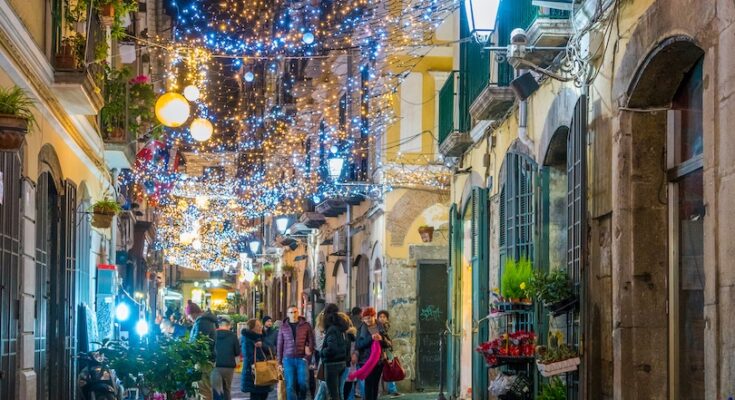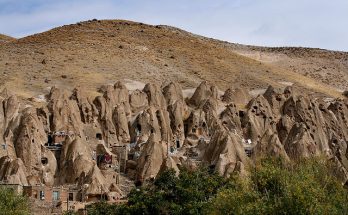A trip to Salerno is bucking the trend, with the traveling crowd heading further west along the Amalfi Coast. Those that stay behind are left with a city that won’t easily release its secrets.
Facing the eye-catching Gulf of Salerno, the city itself can at first appear gritty. It’s old buildings, weary from centuries of life, mix in oddly with modern structures and a burgeoning waterfront.
But exploring the Centro Historico on foot peels back the curtain on Salerno to reveal a town deeply connected to prehistoric Campania, ancient Rome and the Renaissance. History and culture flow out of these cathedrals and palaces into the plazas surrounded by bustling trattorias.
While travelers go elsewhere, exploration of all the things to do in Salerno is left to your own devices and creativity. Whenever you choose to venture beyond to the Amalfi Coast, you can do so without fighting for your place in the cue.
Where to Stay in Salerno
Salerno offers two main areas for travelers to stay in. There’s the Historic Center and the waterfront, along Lungomare Trieste.
Salerno’s Old Town surrounds you with beautiful and historic architecture, culture-laden town squares, plus local restaurants and cafes. The bulk of our favorite attractions can be found here.
The waterfront area, however, provides beautiful views of the Gulf of Salerno, modern amenities and easier connections to the Amalfi Coast.
A minute’s walk from the train station and along Salerno’s waterfront, the 4-star Hotel Montestella surrounds you with options. The modern hotel comes with upscale amenities, buffet breakfasts and easy access to town and the coast.
Another cozy spot to crash is the Hotel Plaza, which sits near both the train station and the waterfront. With its spacious rooms, affordable rates and rooftop terrace this 3-star hotel is a great budget option.
How to get there

From Rome, the best way to get to Salerno is via train. You can find direct trips that take around an hour. Another option is to fly into Naples from which you can take a one-hour train journey. Buses from either arrival point will be cheaper, but stuffier on board.
From anywhere along the Amalfi Coast, you’ll find a long list of ferries to take you to Salerno, with excellent views along the way.
Map of Things to do in Salerno
17. Complex of Santa Sofia

First developed in the latter years of the 10th century, the Complex of Santa Sofia was the first of its kind dedicated to the saint. A stone’s throw from the Piazza Abate Conforti, the original Benedictine convent, housed monks for 200 years.
Later, nuns took up residence here before the complex undertook multiple roles into the 20th century. These include serving as a civil court and becoming a state school.
Today, however, the Complex of Santa Sofia has been restored to her former glory with its doors open to the public. Come and admire the historic stucco work, the church’s central nave, high altar and soaring dome.
16. Medieval Aqueduct

Known as the Bridges of the Devil, the Medieval Aqueduct was constructed in the 9th century. However, as legend would have it, the aqueduct took the devil a single hard-working night to complete. In fact, if you wander under the arches at night, you may even encounter the man himself.
Whichever you choose to believe, the Medieval Aqueduct is a captivating connection to the Middle Ages. You will find it in the historic heart of Salerno close to the Arechi Castle. From its ancient beginnings, the aqueduct supplied water to the St. Benedict Monastery, and it is a poignant reminder of the engineering capabilities of the era.
15. Lungomare

With your morning coffee in possession, make your way down to Lungomare. This is a shady and refreshing tree-lined parkway that stretches along Salerno’s waterfront.
Early risers can be found walking with a hearty pace along the promenade alongside cyclists. The mix of paths and green spaces provides plenty of space to not just move but also kick back and enjoy the views.
Speaking of, facing out to the west, this is a vibrant spot to take in the nightly sunset. Steps from waterfront restaurants, cafes, and bars it’s a simple task to carry on with the evening once the sun has fallen.
14. Chiesa San Pietro a Corte

Representing the best-preserved Medieval construction in Salerno, Chiesa San Pietro a Corte is a fascinating look into ancient Campania. Built in the year 774 by the duke of Benevento, it’s the only remaining palace in Europe that used Longobard architecture.
With the palace is the Upper Room, which stands upon a significant Roman spa complex that dates back to the late 1st century. A bath house that was later repurposed as a resting place for major figures in Salerno’s Middle Ages.
Visitors can explore the Upper Room, which is connected to the neighboring chapel. Along the way, you’ll be presented with a grand staircase from the 1500s.
13. Luci d’Artista

Most travelers flock to this region during the warmer months. However, any who buck the trend may come face to face with the beautiful and illuminating Luci d’Artista.
The popular Christmas event brings locals from across Campania and the Amalfi Coast. Spread across the heart of Salerno are light installations along major streets and atmospheric public squares. It makes for an exciting experience, one complemented by the holiday season and all the hope, love, and happiness it brings.
Such is the scale of Luci d’Artista, that you won’t be able to see it all in one night. All the more reason to spread it out and also pay a visit to the Christmas Market.
12. Provincial Art Gallery of Salerno
Housed within the Palazzo Pinto, the Provincial Art Gallery of Salerno focuses on art from the Renaissance through to the 18th century, with the addition of some international work.
For art aficionados, it presents a grand opportunity to see amazing paintings and creative pieces from the most renowned creative era. The main focus is local artists from this period, allowing you to experience at as it was in Salerno during this time.
The palace itself, once home to Salerno’s aristocrats, overlooks the Via dei Mercanti. Visitors will enjoy the views both of Salerno and the elegant coast. But within lays the real treasures from the Late Mannerism period to Giordano’s Late Baroque from the 17th and 18th centuries.
11. Vietri sul Mare

Below, we discuss the virtues of exploring the Amalfi Coast from Salerno. But there’s one town, Vietri sul Mare, that we purposely ignored. It is a hidden gem along this famous coastline, one without crowds, with stunning terra-cotta rooftops and marvelous vistas.
Just 15 minutes from Salerno, there’s no journey involved between the two. If you arrive by train, the view right out of the station will help you capture Vietri sul Mare in all her glory.
In a heartbeat you can be wandering a relatively undiscovered (from a tourist perspective) town where delightful beaches, old-time ceramic shops and vibrant local culture create a memorable destination.
10. Castello di Arechi

A quick bus ride from the central square will take you to the precipice of Castello di Arechi. One of the most fascinating sights in Salerno, the story of this castle begins in the 8th century before its most recent restoration…in the 1500s.
Castello di Arechi stands dramatically over 250 meters 820 feet above Salerno. Its imposing presence is hard to ignore. Much of this is because of its original purpose, a Byzantine fort. The Normans transformed it into a renowned castle, one that now boasts amazing views.
Visitors will enjoy gazing upon the rooftops of Salerno and well out into the gulf. But not before exploring to collection of antiquities such as ancient armor, currency and ceramics. Summertime travelers may also stumble upon various special events and concerts.
9. Provincial Archaeological Museum

For over nine decades, the Provincial Archaeological Museum has enamored visitors with its permanent and temporary exhibits. As the museum’s name suggests, these showcase various local and national discoveries, taking you on a journey back thousands of years.
Entering the Provincial Archaeological Museum takes you through a delightful garden where ancient Roman statues and art welcome you. From there, you’ll venture across two stories where the historic artifacts, fashion and culture are displayed in chronological order.
Not just a collection of artifacts, the museum elaborates on culture and popular trends that existed in every era, from prehistoric Campania to the height of the Roman era.
8. Trip to the Amalfi Coast

Salerno’s size and position makes it an envious spot from which to explore the Amalfi Coast. A combination of ferries, public transport and private services gives travelers the full spectrum of options that best suit their budget.
From Salerno, you’ll be a mere 30 minutes from Amalfi and just over an hour from the iconic coastal town of Positano. Both are easily reached via ferry, allowing you to avoid the narrow, winding, cliffside roads of the Amalfi Coast. The latter being an adventurous, budget friendly option.
Other places, such as the Greek ruins of Paestum, Naples, and Pompeii, are also easy to reach. Importantly, most traffic flows to and from Sorrento, allowing you to go against the grain and avoid the crowds.
7. Villa Comunale

The Minerva Gardens may have historic significance in Salerno, but the town’s main green space remains the Villa Comunale. Featuring plant species from across the Mediterranean and similar global ecosystems, the garden is a popular gathering spot for locals.
The Villa Comunale was created in 1874. But some parts of the gardens are even older, including the beautiful Tullio Fountain from the late 1700s. Walking paths lead to colorful gardens and elegant landscapes, interrupted by striking figures from local and national history.
In summer, crowds gather for music and events. While in winter, the Villa Comunale comes to life with spectacular lights that illuminate the gardens.
6. Chiesa di San Giorgio

A stone’s throw from the Salerno Cathedral, the Chiesa di San Giorgio, dates back to the start of the 8th century. It’s a stunning piece of Baroque architecture and is the oldest monastic settlement in the region.
What we see today isn’t quite what early members of the monastery enjoyed. Indeed, it was a simple beginning, one that blossomed in the 16th and 17th centuries. Inside, visitors wonder at the elegant frescoes that are splayed across the sprawling ceiling.
Artwork is prominent in the Chiesa di San Giorgio. Highlights include Madonna and Child with Saints, a 16th century piece by Andrea Sabbatini along with works by Giacinto de Popoli.
5. Museo Diocesano San Matteo

Within the Historic Center, the Museo Diocesano San Matteo harbors a spectacular collection of art and antiquities from the Middle Ages to the 20th century.
Your experience here begins by exploring a spacious courtyard surrounded by history, art and endless tales. Wander up to the first floor where the gallery opens up, beginning your journey back through time.
Close to the Salerno Cathedral, the museum houses an extensive collection of religious art that once stood within the historic building. These include scenes from the Old and New Testaments that were created at the beginning of the 12th century.
The bulk of the works take you from the Middle Ages through the Renaissance, featuring such artists as Roberto D’Oderisio and Vincezo De Rogata.
4. Trip to Paestum

You’ll be in no rush to depart Salerno. But there are a number of day trips that travelers can complete. One not to miss as a trip to Paestum. This is a historic Greek city that was founded in the 7th century BC. Outside of Greece itself, there are few better places to explore and experience ancient Greek ruins.
Often overlooked, you’ll be stoked you ventured off the beaten path and come face to face with the Temple of Hera. This captivating structure remains incredible in place over 2,500 years since it was first complete.
While you can visit Paestum from along the Amalfi Coast, Salerno provides the best launch point. Their direct buses will place you in this magical destination in under an hour.
3. Minerva Gardens

Starting near the Arechi Castle and running all the way to Villa Comunale, the Minerva Gardens are a beautiful botanical garden whose origins begin in the 1300s. The gardens are a source of great pride for locals, a space that started thanks to the work of Matteo Silvatico. A man who graduated from the oldest medical university on earth.
The gardens began as a place for students to recognize medicinal plants that were prominent in the Middle Ages, such as the mandrake. Fast forward to today, the garden has evolved to evoke a sense of awe and wonder in its visitors.
Guided tours take place daily. This provides more than just an understanding of the plant species on display, but also the history of the Minerva Gardens and its link to the Salerno Medical School.
2. Centro Storico

The major towns along the Amalfi Coast battle it out for visitors’ attention armed with amazing scenery, from cliffside beaches to the Mediterranean. One major strength of Salerno is its Historic Center.
Known as the Centro Storico, Salerno features one of the best preserved old towns along this part of Italy. Many of the features of this part of Salerno have been mentioned in our guide, including the 9th century Medieval Aqueduct and the beauty of Lungomare.
Another highlight of the Historic Center is the Fruscione Palace. The 13th century palace features frescoes and mosaic work from the 2nd century that were once a part of ancient Roman baths.
Exploring Salerno’s Centro Historico puts you in touch with the town’s rich history while elevating Salerno’s modern-day culture.
1. Salerno Cathedral

Seemingly every town in Italy has an eye-catching cathedral that will stop you in your tracts. Salerno is no different. However, the draw of the Salerno Cathedral isn’t necessarily the vibrant facade, vaulted ceilings, or towering spires.
The Salerno Cathedral is dedicated to St. Matthew and took eight years to complete, beginning in 1076. Now, thanks to a 1930s rejuvenation, the cathedral shines with its former splendor.
The exterior bell tower is the first element to draw you in, then the mullioned windows and Romanesque facade. But the real gems remain inside. Here, you’ll find over two dozen columns with boasting Arab art and ancient sarcophagi.
Further exploration brings you to a stunning crypt that houses the remains of St. Matthew and features a vaulted hall.C



